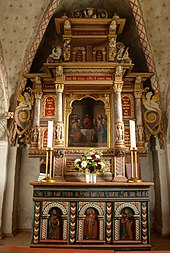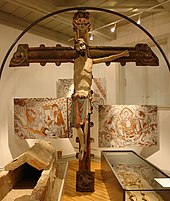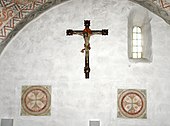Church of Tuse
The Evangelical Lutheran Church of Tuse ( Danish Tuse Kirke ) belongs to the parish Tuse Sogn in the Holbæk municipality . The village of Tuse is located in the north-west of the Danish island of Zealand ( Danish Sjælland ), 7 km west of Holbæk . The originally Romanesque church was enlarged in the 15th century and contains extensive frescoes from this period. Pulpit, altar and other inventory date from the 16th to 17th centuries. A large triumphal cross from around 1250 is now in the Holbæk Museum .
Church building
The Romanesque church from around 1200, originally made of field stone , was extensively expanded in the Middle Ages. In the 15th century Gothic vaults were raised in the choir and a little later two vaults were added to lengthen the nave . Where the old and the new church house meet, a large buttress on the north side is evidence of a support for structural reasons. On the south side this place is covered by the vestibule ( armory ), which was built around the year 1500. The tower in the west was given the white-painted brick church, which resembles a typical Danish country church with its stepped gables , at the beginning of the 16th century - shortly before the Reformation .
inventory
pulpit
The pulpit from 1584 has a staircase from a later period. In four large fields separated by columns, foliage and masks have been cut. Against the wall there is a fifth field with no carvings, it is only painted. The Latin text in the fields reads: "VERBVM DOM (I) NI MANET IN ÆTERNVM" (The word of the Lord endures forever). The year 1684, carved on the upper edge, is 100 years wrong. The large sky protruding into the window recess indicates that the pulpit originally stood in front of the choir, as there are examples in Jutland . The rosette in heaven replaces the otherwise common dove as a symbol of the Holy Spirit . The information about 1857 on the altar and 1858 (MDCCCLVIII) on the pulpit indicate a major restoration .
altar
The front of the altar table, with the image of Christ blessing with the globe in the middle, dates from the first quarter of the 17th century. On the left edge of the picture the apostle Peter with the key, on the right a man reading. Probably St. Andrew (behind him a specially designed cross ), it could also be Paul , who is often depicted with the book. At the top and bottom a banner with words from the Gospel of John 3.16.
The altar panel bears the year 1625. Above the predella painted with biblical sayings the altarpiece . In the middle there are four columns with figures of women who carry tools that were used to torture Jesus: whip and rod, torture stake, hammer and nails, and the cross. The painting of Holy Communion was probably used in a thorough restoration in 1858. Naked female figures on either side of the midfield.
Above the middle field, female allegories of virtue : towards the north (left) hope and love, towards the south from faith and strength. A figure of John the Baptist stood on the southern cornice until very recently , from which it has been concluded that a similar figure of Moses stood on the north side. The theme varied on the board is the Law of Moses (the painted commandments) and grace (Holy Communion). Above, the Creator or Savior is enthroned with the globe, surrounded by flames.
The panel bears the coats of arms of the probably original donor, Alexander Rabe v. Pappenheim and his wife. From 1620 to 1627 he was a feudal lord at Holbæk . Originally, the altar was hardly intended for this church because it is almost too big for the space. That is why both the board and the masonry had to be reduced in some places.
Further inventory
The granite baptismal font (around 1300) is smoothly carved, with ten blinds and a circular ornament. It is a replica of the Gotland baptismal font , one of which is in Butterup's neighboring church. The baptismal font and altar candlestick are very modern as they replace older church inventory that was stolen in 1981. During the theft, the aforementioned figure of John the Baptist was also removed from the altar panel.
The church has had three crucifixes up to the present day. The 253 cm triumphal cross from around 1250 is now in the Holbæk Museum . The crucifix on the north wall is from the first quarter of the 16th century. The two bells date from 1626 and 1761. The organ from Poul-Gerhard Andersen's Orgelbyggeri from 1990 has six stops , manual and pedal .
Murals
Around 1460–80, the Isefjord workshop made a painting that probably covered the walls and vaults of the choir and nave. Only two pictures of the wall paintings have survived, while the pictures in the vault - apart from the choir - are almost intact. The Isefjord workshop has done a number of paintings in churches in Zeeland. The poor man's Latin Bible , which also contained depictions of saints and moral allegories , served as a template . They were implemented in the characteristic depictions, whereupon people appear in contemporary costumes - the good guys are happy and round-cheeked, the bad guys very suspicious. It is shown in a special way that an action takes place inside: a diced carpet is painted for the events in front of the houses. The colors are black, gray and especially red tones.
After preliminary investigations in the years 1888–1889 whether the painted over frescoes could be restored, restoration began in 1890.
Choir vault
It was known that the story of creation was once depicted on the choir ceiling , but no attempt was made to restore it because of the only remnants of the images here. The decoration with stars and tendrils was preserved in the original style and transferred to the whole vault.
On the triumphal wall - the wall between the nave and the choir - on the south side there is a picture of St. King Olav with the warrior's ax and the chalice of the church , who tramples the crowned Midgard serpent of paganism. The painting has had to be heavily restored, but its placement suggests that he had an altar here as the patron saint of the church.
Eastern vault
The story of the childhood of Jesus is depicted in the east vault of the ship. The rest of his life, especially scenes from the Passion , were on the walls. These pictures too were too badly preserved to be restored at the end of the 19th century. The scenes, starting with the northern cap (opposite the pulpit):
- Birth of Jesus in the stable with ox and donkey. On the left Joseph (who prepares the Kindelbier) and shepherds playing bagpipes with angels. The banner reads: “Gloria in excelsis Deo” (Glory to God on high). Including two motifs that have to do with Maria's pregnancy. The Archangel Gabriel proclaims the upcoming events to the future Mother of God ( Lk 1.28 EU ): "Ave gracia plena dominus tecum" (Greetings, you most blessed, the Lord is with you) and Mary answers ( Lk 1.38 EU ): " Ecce ancilla d (omi) ni fiat michi secu (n) du (m) verbu (m) tuu (m) “(See, I am the Lord's handmaid, it will happen to me according to Your word). Right in the picture the visitation : Mary meets her older relative, Elisabeth, who is pregnant at the same time as John the Baptist . The man with the blooming staff is Joseph, the bridegroom of Mary .
- The main image is the adoration of the kings who bring their gifts: rulership (symbolized by the crown) and wealth. In the background Joseph cashing in at his shrine. On the small picture on the left the circumcision of Christ is shown, on the tape: "Circu (m) cisio". The operation is not seen as a particularly Jewish custom, but is performed here by a Christian bishop with a huge knife, as a symbol of the later sufferings of Christ. On the right, Jesus is presented in the temple, seen here as a Christian church that was familiar to the people.
- The child murder in Bethlehem , depicted with two locations: In Jerusalem , King Herod gives his soldiers the order to kill all the boys in the city of Jesus' birth and this murder is depicted in the other pictures. The picture on the right tells of the grain miracle that took place during the flight to Egypt .
- Meeting of three living and three dead kings . The nullity of earthly life is specifically emphasized and the dead with their worms and maggots address the living: "Vos qui transitis n (os) t (r) i me (m) ores rogo sitis" (you who pass by, I ask Yourselves: Remember us), says the first. The second: “Quod sumus hoc eritis” (What we are now, you should become one day) and the last: “Fuimus aliquando quod estis” (We were once what you are now). Above their heads you can read: "Heu qua (n) tus est noster dolor" (Oh, our pain is great). The childhood of Jesus continues on the side pictures: on the left the flight to Egypt again. Maria rides the donkey. On the right, Jesus has to come to school and is brought there by Mary. The schoolmaster with stick and rod. Like the other students keeps Jesus a book in his hand, but has a halo around his head, while the other pointed caps ish.
Western vault
In the western vault - in front of the tower, which has no paintings - the time of the church is depicted, with its saints, everyday life, heaven and hell :
- Jesus, enthroned on the judgment seat on the last day , in a large almond-shaped halo with the globe at his feet. Mary stands on one side and the apostle John on the other. Jesus shows his five wounds, and out of his mouth there is the lily of grace on one side and the sword of anger on the right. On the lily side the text says: "Venite benedicti i (n) regnu (m) p (at) ris mei" (Come you blessed ones into the kingdom of my father), while the others get these words: "Ite maledicti i (n) igne (m) eternam “(Lift yourself away, you damned ones, to the eternal fire). Below him are represented the risen, raised by trumpet angels. Her command is: “Surgite mortui venite ad” (Stand upon you deceased and come to) - there is no room here for the words “God's judgment”.
- In the jaws of hell devils drive those souls who must go to eternal torment. They can be kings as well as bishops and monks. If you don't want to go yourself, you will be driven on the dung cart or brought in flight. The small pictures below show a few everyday scenes: brewing beer on the left and buttering on the right, but devilishly distorted: the beer lady fills beer, but is tapped by a devil herself, on the right a few devils help the woman with her work. Are they sorceresses or do you find a warning to women here: stay on the path of virtue, otherwise you can see how you will fare.
- Opposite the heavenly city . Here St. Peter stands with the key and receives the blessed. Including two examples of how to get there: Saint Martin of Tours gives half of his cloak to a poor beggar and on the other hand Saint Michael weighs the soul against its works while a few devils try to push the scales down.
- Saint George's fight with the dragon while the princess (with lamb) and her benevolent parents watch him. Below him are several bloody depictions of saints: on the right, St. Laurentius on the grate, tortured by three energetic devils. "Assatus sum. Com (m) edite ”(I am ready, serve yourselves), the holy man says to his executioners, while he exclaims with all his heart and to God:“ Gr (ati) as tibi ago d (omi) ne ih (es ) u christe qv (ia) portas celi i (n) gredi merui “(I thank you Lord God Jesus Christ because I am admitted through the gate of the kingdom of heaven). On the other hand, the executioners pull the bowels out of Saint Erasmus , where he only smiles mischievously.
Wall of the west side
Above the old man's door on the west side of the ship there are a few frescoes that have recently been restored. The main piece is the so-called wheel of fortune: the king on the way up - "regnabo" (I will rule) - and the king on the battlements of his power - "regno" (I rule) - have been preserved, but not the two images of the Decline and impermanence . On the left you can see a banner on which only the name "Salomon" could be reliably read during the restoration.
Consecration crosses
On the walls in the church there are a number of consecration crosses , which were probably painted on places that were sprinkled with holy water by the bishop on the occasion of church dedications, for example after a major renovation, such as in the 16th century after the construction of the tower.
literature
Bibliography for the church brochure:
- "Nationalmuseets Kirkevaerk", (Volume 7) describes the church of Tuse and other churches in Holbaek County
- "Danmarks Kalkmalerier, Gotik" (Volume 4) describes the frescoes seen in a larger context
- Niels M. Saxtorph: "Danmarks Kalkmalerier" Politikens Forlag (several editions)
- Helge Larsen: "Hjulet drejer - Middelalderen omkring os", a brief treatment of a number of the most important frescoes in the Holbaek area
Individual evidence
- ↑ a b c d e f g h Henrik Schovsbo, translation: Sten Rasmussen: Tuse Church . Tuse Meninhedsråd, Tuse 1997.
- ↑ a b c d Tuse Kirke (PDF; 6.5 MB) In: IV, bind 1 (1979), Side: 587-617 . National Museum - Danmarks Kirker. Retrieved December 2, 2012.
- ↑ John 3, Standardized Translation . ERF Online. Retrieved December 4, 2012.
- ↑ Orgelbygger - Tuse Kirke . National Museum. Retrieved December 11, 2012.
Web links
- Website Tuse Kirke (Danish)
- Tuse Kirke at nordenskirker.dk
- Tuse Kirke at danmarkskirker.natmus.dk
Coordinates: 55 ° 42 ′ 55.8 " N , 11 ° 36 ′ 57.9" E


















